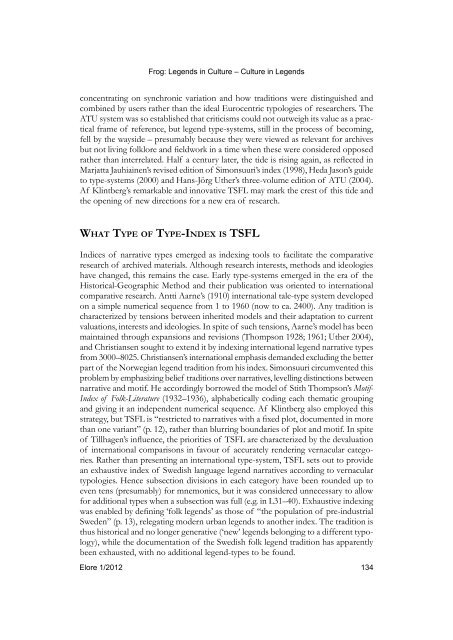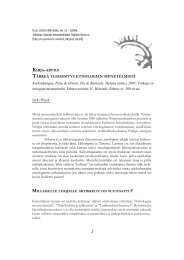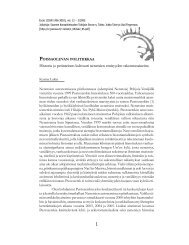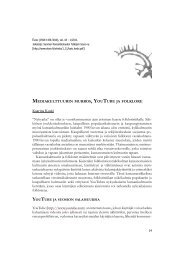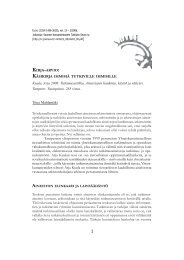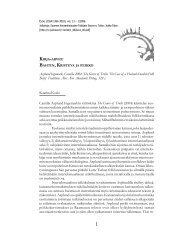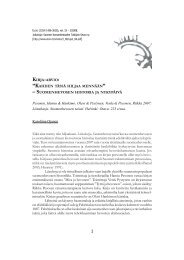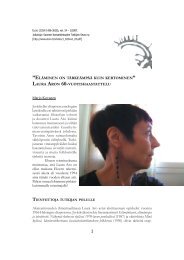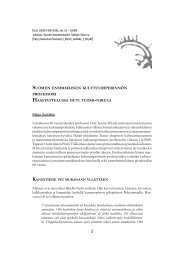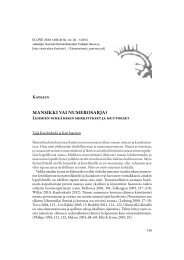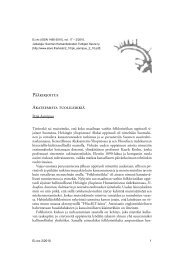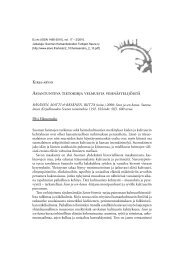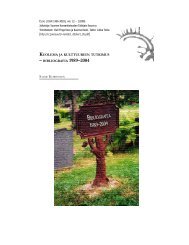Muutoksen tuulia - Elore
Muutoksen tuulia - Elore
Muutoksen tuulia - Elore
You also want an ePaper? Increase the reach of your titles
YUMPU automatically turns print PDFs into web optimized ePapers that Google loves.
Frog: Legends in Culture – Culture in Legends<br />
concentrating on synchronic variation and how traditions were distinguished and<br />
combined by users rather than the ideal Eurocentric typologies of researchers. The<br />
ATU system was so established that criticisms could not outweigh its value as a practical<br />
frame of reference, but legend type-systems, still in the process of becoming,<br />
fell by the wayside – presumably because they were viewed as relevant for archives<br />
but not living folklore and fieldwork in a time when these were considered opposed<br />
rather than interrelated. Half a century later, the tide is rising again, as reflected in<br />
Marjatta Jauhiainen’s revised edition of Simonsuuri’s index (1998), Heda Jason’s guide<br />
to type-systems (2000) and Hans-Jörg Uther’s three-volume edition of ATU (2004).<br />
Af Klintberg’s remarkable and innovative TSFL may mark the crest of this tide and<br />
the opening of new directions for a new era of research.<br />
What Type of Type-Index is TSFL<br />
Indices of narrative types emerged as indexing tools to facilitate the comparative<br />
research of archived materials. Although research interests, methods and ideologies<br />
have changed, this remains the case. Early type-systems emerged in the era of the<br />
Historical-Geographic Method and their publication was oriented to international<br />
comparative research. Antti Aarne’s (1910) international tale-type system developed<br />
on a simple numerical sequence from 1 to 1960 (now to ca. 2400). Any tradition is<br />
characterized by tensions between inherited models and their adaptation to current<br />
valuations, interests and ideologies. In spite of such tensions, Aarne’s model has been<br />
maintained through expansions and revisions (Thompson 1928; 1961; Uther 2004),<br />
and Christiansen sought to extend it by indexing international legend narrative types<br />
from 3000–8025. Christiansen’s international emphasis demanded excluding the better<br />
part of the Norwegian legend tradition from his index. Simonsuuri circumvented this<br />
problem by emphasizing belief traditions over narratives, levelling distinctions between<br />
narrative and motif. He accordingly borrowed the model of Stith Thompson’s Motif-<br />
Index of Folk-Literature (1932–1936), alphabetically coding each thematic grouping<br />
and giving it an independent numerical sequence. Af Klintberg also employed this<br />
strategy, but TSFL is “restricted to narratives with a fixed plot, documented in more<br />
than one variant” (p. 12), rather than blurring boundaries of plot and motif. In spite<br />
of Tillhagen’s influence, the priorities of TSFL are characterized by the devaluation<br />
of international comparisons in favour of accurately rendering vernacular categories.<br />
Rather than presenting an international type-system, TSFL sets out to provide<br />
an exhaustive index of Swedish language legend narratives according to vernacular<br />
typologies. Hence subsection divisions in each category have been rounded up to<br />
even tens (presumably) for mnemonics, but it was considered unnecessary to allow<br />
for additional types when a subsection was full (e.g. in L31–40). Exhaustive indexing<br />
was enabled by defining ‘folk legends’ as those of “the population of pre-industrial<br />
Sweden” (p. 13), relegating modern urban legends to another index. The tradition is<br />
thus historical and no longer generative (‘new’ legends belonging to a different typology),<br />
while the documentation of the Swedish folk legend tradition has apparently<br />
been exhausted, with no additional legend-types to be found.<br />
<strong>Elore</strong> 1/2012 134


